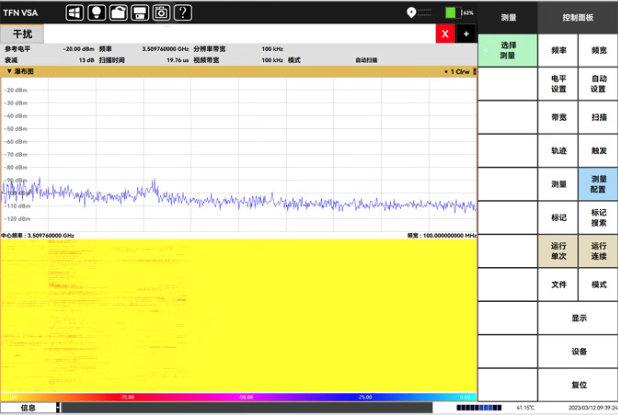The role of real-time spectrum analysis bandwidth in transient signal spectrum analysis - taking TFN RMT716A spectrum analyzer as an example
1. The importance of real-time spectrum analysis bandwidth
What is real-time spectrum analysis bandwidth?
Real-time spectrum analysis bandwidth (RTBW) is the maximum frequency range that a spectrum analyzer can continuously capture and analyze signals under gapless scanning. For transient signals (such as burst pulses, frequency hopping signals or short-term interference), a wider real-time bandwidth can fully capture the instantaneous characteristics of the signal and avoid data loss or distortion caused by insufficient bandwidth. Especially in the fields of 5G communications, radar detection and the Internet of Things, high-bandwidth real-time analysis capabilities have become the core indicator of equipment performance.
RMT716A's 100MHz bandwidth advantage
The TFN RMT716A handheld spectrum analyzer supports a maximum real-time spectrum analysis bandwidth of 100MHz, far exceeding the 10MHz level of traditional devices. This breakthrough design enables it to cover a wider frequency band at the same time. For example, in 5G NR signal analysis, it can capture and analyze large-bandwidth signals at one time, significantly improving test efficiency in complex scenarios. Combined with its high dynamic range (DANL ≤-160dBm/Hz) and fast scanning capability, the RMT716A demonstrates excellent sensitivity and accuracy in transient signal detection.
2. Analysis of the real-time spectrum analysis mode of the TFN RMT716A spectrum analyzer
Persistence measurement mode: Capturing signal probability distribution
The persistence measurement function of the RMT716A intuitively presents the frequency of signal occurrence through a three-dimensional spectrum (frequency-amplitude-probability). The color gradient changes from red (100% probability) to blue (0% probability), helping users quickly identify hidden transient interference. For example, in wireless communication base station testing, the 100MHz real-time bandwidth can simultaneously monitor burst noise in multiple frequency bands and accurately locate abnormal signal sources through probability superposition.

Waterfall chart measurement mode: dynamic tracking in the time dimension
The waterfall chart function uses frequency as the horizontal axis and time as the vertical axis to dynamically record the historical changes in signal amplitude. The waterfall chart of the RMT716A supports high-resolution display, and users can analyze the duration and frequency domain characteristics of transient signals through the playback function. In electromagnetic compatibility (EMC) testing, this mode can clearly display the propagation path of the pulse signal, providing a visual basis for tracing the source of interference.
3. Achievement of wide test range and accuracy
Expansion of test range brought by wide bandwidth
RMT716A's 100MHz real-time bandwidth greatly expands the coverage of a single scan. Taking LTE signal testing as an example, the 20MHz channel analysis that traditional equipment needs to be completed by multiple segmented scans can be completed by RMT716A in one go, and adjacent channel interference can be detected simultaneously. The "afterglow monitoring quantity" function of RMT716A combined with the wide bandwidth characteristics can quickly distinguish the main signal from transient spurious in a complex electromagnetic environment to avoid the risk of missed measurements.
Technical guarantee for high-precision measurement
To achieve high precision, RMT716A adopts low phase noise design (≤-127dBc/Hz@1MHz offset) and adaptive attenuation technology. Users can manually set the resolution bandwidth (1Hz~3MHz) and video bandwidth to ensure the best signal-to-noise ratio under different signal strengths. In addition, its trigger function (free trigger, external trigger) supports precise synchronization of transient signals to reduce measurement errors caused by time jitter.
4. Analysis of actual application scenarios
Transient signal capture case: frequency hopping communication system test
In the test of military frequency hopping radio stations, the real-time spectrum analysis mode of RMT716A can track the frequency switching process throughout. By setting a 100MHz bandwidth, the device can capture the instantaneous power and dwell time of each frequency point in the frequency hopping sequence and generate a time-frequency correlation report. The "time gate measurement" function of the RMT spectrum analyzer further supports signal analysis of specific time windows, effectively separating the target signal in the mixed spectrum.
Performance in complex signal environment: 5G base station interference troubleshooting
Facing the dense deployment scenario of 5G base stations, the real-time bandwidth of RMT716A can monitor multiple carrier aggregation signals at the same time. Combined with the waterfall function, engineers can quickly identify instantaneous interference caused by neighboring cell overlap or equipment failure. The "5GNR signal time domain power measurement" function of the RMT716A spectrum analyser can quantify signal fluctuations and assist in optimizing base station parameter configuration.
Conclusion
Real-time spectrum analysis bandwidth is a core capability indicator for transient signal detection. TFN RMT716A frequency analyzer provides an efficient solution for signal analysis in complex electromagnetic environments with its 100MHz real-time bandwidth, persistence and waterfall dual modes, and high-precision hardware design. Whether it is communication system debugging or interference troubleshooting, its wide coverage and high accuracy can significantly improve test efficiency and reduce operation and maintenance costs. For industry users who need to cope with transient signal challenges, RMT716A is undoubtedly a trustworthy professional tool.
